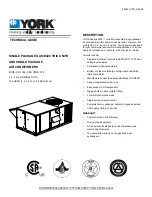
36
Multi F Standard W
all-Mounted Indoor Unit
Due to our policy of continuous product innovation, some specifications may change without notification.
©LG Electronics U.S.A., Inc., Englewood Cliffs, NJ. All rights reserved. “LG” is a registered trademark of LG Corp.
MAX
MULTI
F
MULTI
F
PIPING CONNECTIONS
IDU to ODU
Installing Refrigerant Piping Insulation
WARNING
Ensure all refrigerant piping is insulated. Exposed refrigerant piping may cause burns if touched.
Wrap all refrigerant and condensate piping including field-provided isolation ball valves and flexible pipe connection kits
provided by LG. All pipes must be insulated and each pipe must be separately wrapped. Any exposed piping may gener-
ate condensate or will cause burns if touched. Sufficiently insulate all cold surfaces to prevent moisture forming.
Ensure insulation material fits snugly against the refrigeration pipe with no air space between the pipe surface and the
surrounding insulation.
Protect insulation inside hangers and supports with a second insulation layer. Ensure insulation on all pipe passing
through pipe hangers, inside conduit, and/or sleeves is not compressed.
Glue all insulation joints with no air gaps. Be sure insulation material fits snugly against the refrigeration pipe with no air
space between it and the pipe. All pipe insulation exposed to the sun and outdoor elements must be properly protected
with PVC, aluminum vapor barrier, or alternatively placed in a weather-resistant enclosure such as a pipe rack with a top
cover; and must meet local codes. Pay special attention to insulating the pipes installed in a ceiling plenum.
Figure 44: Typical Refrigerant Line Flare Fitting Insulation Detail
No Clearance
Overlap Insulation Where the
Port and the Piping Meet
Insulation for Indoor Unit Port
(Field Supplied) Insulation for Refrigerant
Piping (Field Supplied)
Insulation Clip (Field Supplied)
Bands
Insulation
Narrow tape
Field-supplied
piping
Wide tape
Wrap with tape
Indoor unit
piping
Piping
Wrap with tape
Drain hose
Piping
Wide tape
1.
2.
3.
Figure 45: Insulating the Piping.
















































